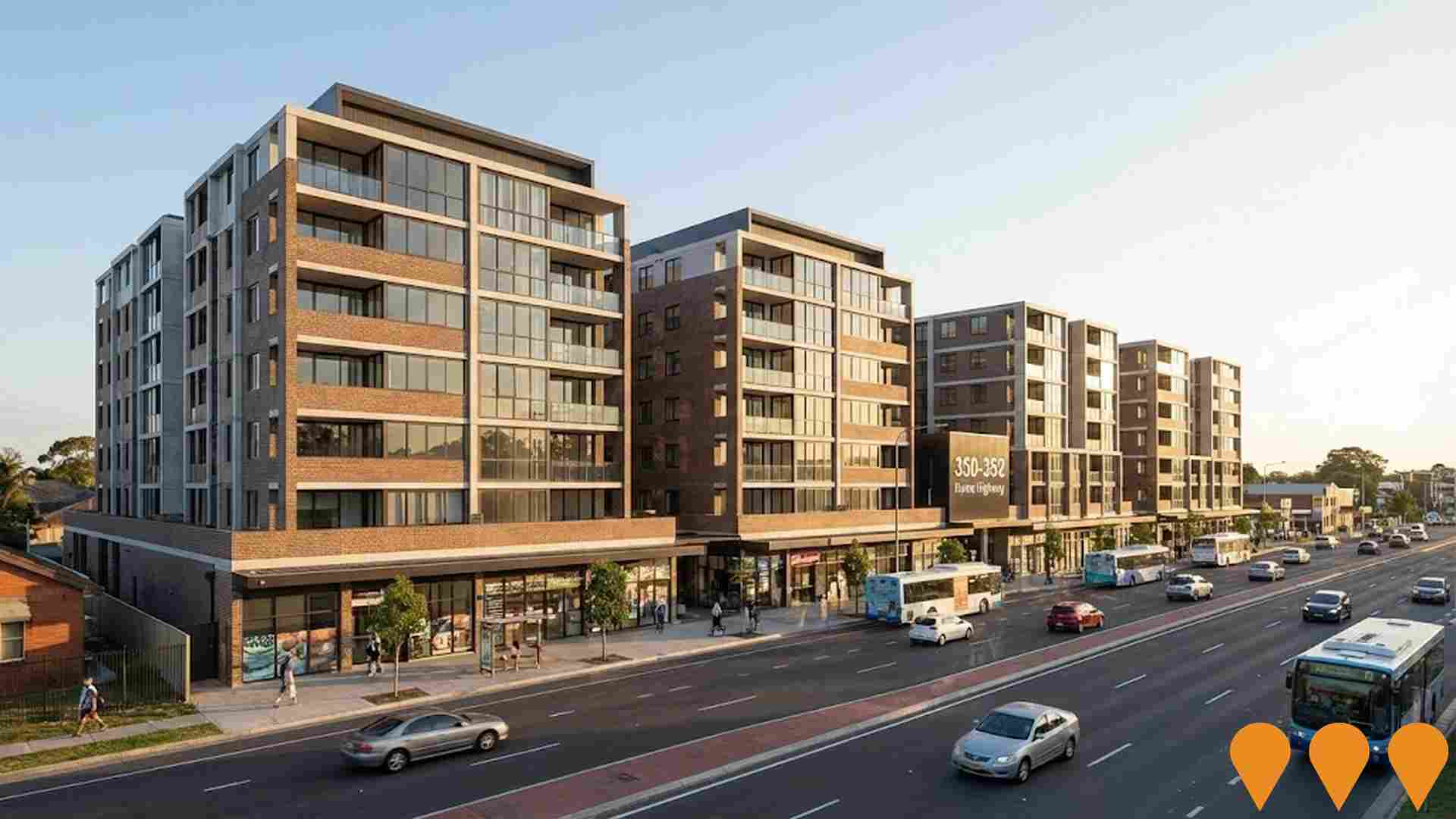Chart Color Schemes
est. as @ -- *
ABS ERP | -- people | --
2021 Census | -- people
Sales Activity
Curious about local property values? Filter the chart to assess the volume and appreciation (including resales) trends and regional comparisons, or scroll to the map below view this information at an individual property level.
Find a Recent Sale
Sales Detail
Population
Population growth drivers in Yagoona - Birrong are strong compared to national averages based on AreaSearch's ranking of recent, and medium to long-term trends
Yagoona-Birrong's population is approximately 23,415 as of August 2025. This figure represents an increase of 931 people since the 2021 Census, which recorded a population of 22,484. The change is inferred from ABS data showing an estimated resident population of 23,409 in June 2024 and an additional 146 validated new addresses since the Census date. This results in a population density ratio of 4,211 persons per square kilometer, placing Yagoona-Birrong among the top 10% of locations assessed by AreaSearch. The area's growth rate of 4.1% since the 2021 census exceeds that of its SA3 region (4.0%), indicating it as a growth leader. Overseas migration contributed approximately 61.9% of overall population gains in recent periods for Yagoona-Birrong.
AreaSearch uses ABS/Geoscience Australia projections released in 2024 with a base year of 2022 for SA2 areas, and NSW State Government's SA2 level projections released in 2022 with a base year of 2021 for areas not covered by the first dataset. These projections are applied to all areas from 2032 to 2041. Future population trends suggest an increase just below the national median, with Yagoona-Birrong expected to expand by 2,304 persons to 2041, reflecting a total increase of 9.8% over the 17-year period based on the latest population numbers.
Frequently Asked Questions - Population
Development
AreaSearch assessment of residential approval activity sees Yagoona - Birrong among the top 30% of areas assessed nationwide
Yagoona-Birrong averaged approximately 116 new dwelling approvals annually over the past five financial years, from FY21 to FY25. A total of 582 homes were approved during this period, with an additional 35 approved so far in FY26. On average, 1.6 people moved to the area per year for each dwelling built between FY21 and FY25, indicating a balanced supply and demand dynamic that maintains stable market conditions.
The average construction cost value of new homes was $436,000, aligning with regional patterns. This financial year has seen $27.2 million in commercial development approvals, suggesting balanced commercial growth activity. Compared to Greater Sydney, Yagoona-Birrong demonstrates comparable new home approvals per capita, preserving market equilibrium consistent with surrounding areas.
The area's new development consists of 56% standalone homes and 44% attached dwellings, offering a mix of townhouses and apartments catering to various price points. With around 226 people per dwelling approval, Yagoona-Birrong exhibits characteristics of a low-density area. Population forecasts project an increase of 2,294 residents by 2041. At current development rates, new housing supply should comfortably meet demand, providing favourable conditions for buyers and potentially supporting growth beyond current population projections.
Frequently Asked Questions - Development
Infrastructure
Yagoona - Birrong has strong levels of nearby infrastructure activity, ranking in the top 30% nationally
The performance of an area is significantly influenced by changes in local infrastructure, major projects, and planning initiatives. AreaSearch has identified a total of 33 projects that are expected to impact the area. Notable projects include the Henry Lawson Drive Upgrade Program, Power Supply Upgrade - Yagoona Station, 25-29 Rookwood Road Yagoona, and 283-289 Cooper Road Redevelopment. The following list details those projects likely to be most relevant.
Professional plan users can use the search below to filter and access additional projects.
INFRASTRUCTURE SEARCH
 Denotes AI-based impression for illustrative purposes only, not to be taken as definitive under any circumstances. Please follow links and conduct other investigations from the project's source for actual imagery. Developers and project owners wishing us to use original imagery please Contact Us and we will do so.
Denotes AI-based impression for illustrative purposes only, not to be taken as definitive under any circumstances. Please follow links and conduct other investigations from the project's source for actual imagery. Developers and project owners wishing us to use original imagery please Contact Us and we will do so.
Frequently Asked Questions - Infrastructure
Bankstown TOD Accelerated Precinct
State-led Transport Oriented Development (TOD) Accelerated Precinct around Bankstown station and CBD. Rezoning effective 27 November 2024 delivering capacity for 14,000 new homes (including 3-4% affordable housing) and 14,300 new jobs across a large mixed-use precinct. Features buildings ranging from 1 to 25 storeys around the new Metro station. Includes new parks, improved transport connectivity, walkways and cycleways. Part of the NSW Government's TOD Program to boost housing supply near major transport hubs. The NSW Government has committed $520 million to provide active transport links and quality public open spaces across TOD Accelerated Precincts. Potential upgrades proposed for Memorial Park and Griffith Park. Development expected over the next 10-15 years.
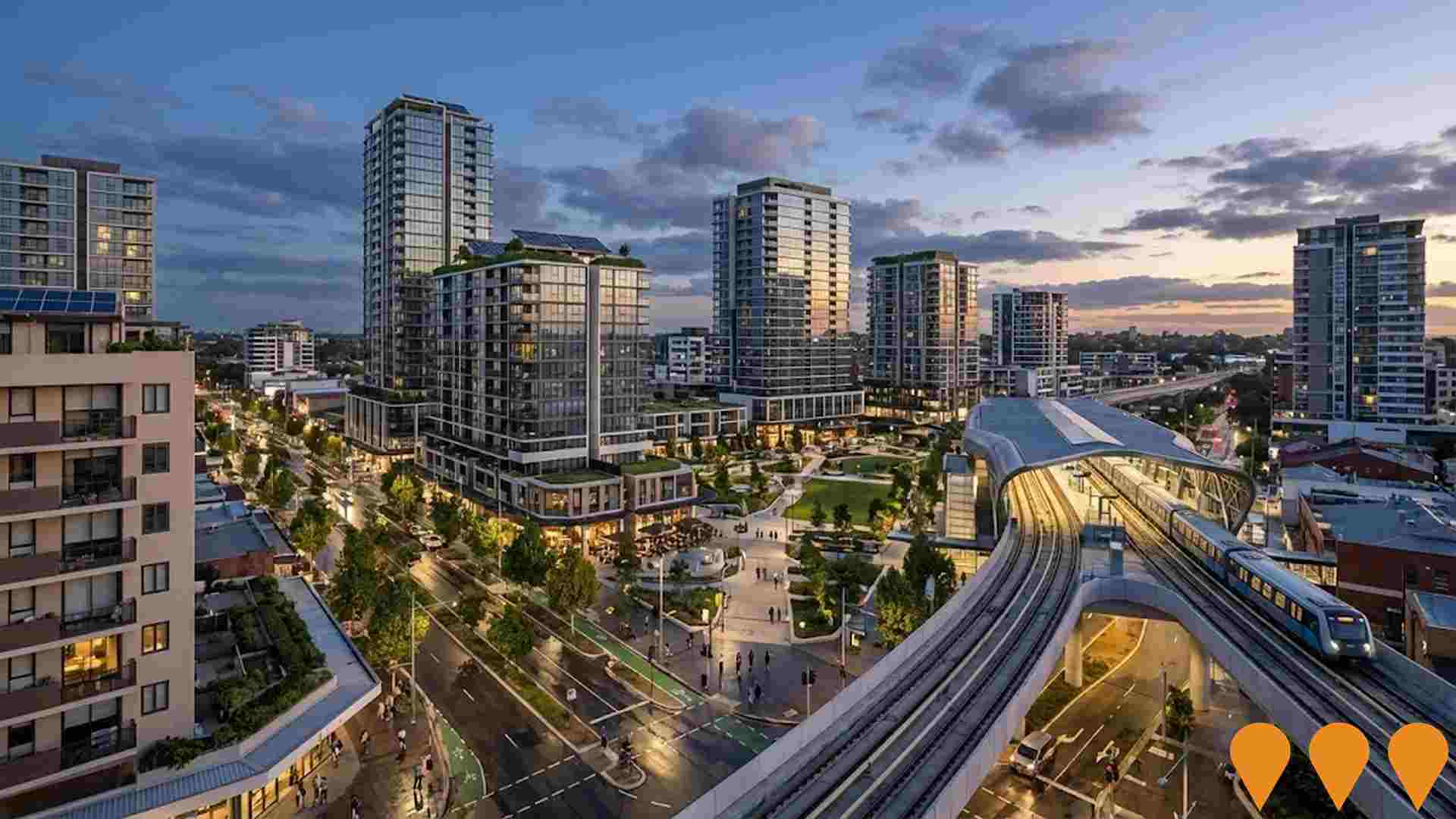
Bankstown CBD Transformation
The comprehensive transformation of the Bankstown CBD is underway. Key components include the Bankstown CBD Upgrade (in construction) and the adoption of the Bankstown City Centre Master Plan (Planning Proposal submitted for Gateway Determination). The Master Plan guides streetscape improvements, new mixed-use developments, enhanced public spaces, and transport connectivity to create a vibrant, walkable city center, celebrating cultural diversity and supporting future growth. Recent completed projects under this umbrella include a $27 million stormwater upgrade, Paul Keating Park Play Space, and The Appian Way Pedestrian Mall transformation. The overall vision is a long-term, multi-developer initiative for Bankstown to become a leading health, education, and jobs hub.

Sydney Metro Bankstown Line Conversion
Conversion of the T3 Bankstown Line between Sydenham and Bankstown to metro standards as part of the Sydney Metro City & Southwest project. Includes upgrades to 11 stations with platform screen doors, new signalling systems, accessibility enhancements (lifts and level access), track modifications, and introduction of autonomous, air-conditioned metro trains with 4-minute peak frequencies. The line closed in September 2024 for intensive conversion works managed by Martinus Rail. Expected to open in 2026 (delayed from earlier targets due to industrial action). Provides fast travel times, e.g., Bankstown to Central in 28 minutes, and forms part of the overall 66 km Sydney Metro network.
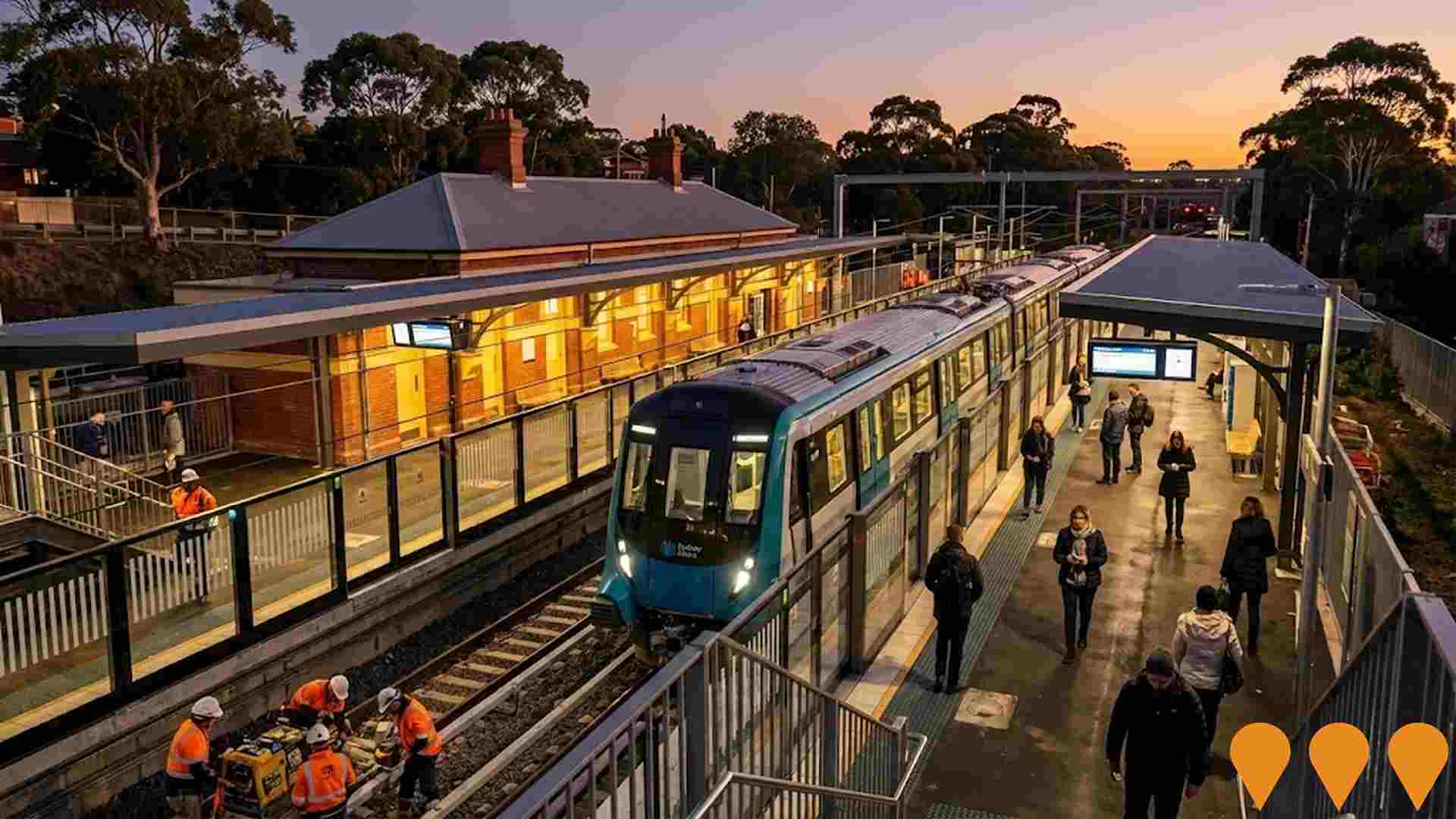
Bankstown Exchange (Stage 1 - Bankstown Central Masterplan)
Stage 1 of the Bankstown Central masterplan delivers approximately 30,000 sqm of A-grade commercial office space across three buildings (two 8-level towers and one 5-level building), ground-floor retail with an activated 'Eat Street' dining precinct, new public plazas, a repositioned bus interchange, basement parking for 320 vehicles, 240 bicycle spaces and end-of-trip facilities. The project is a key catalyst for the Bankstown Health and Education Innovation Precinct.
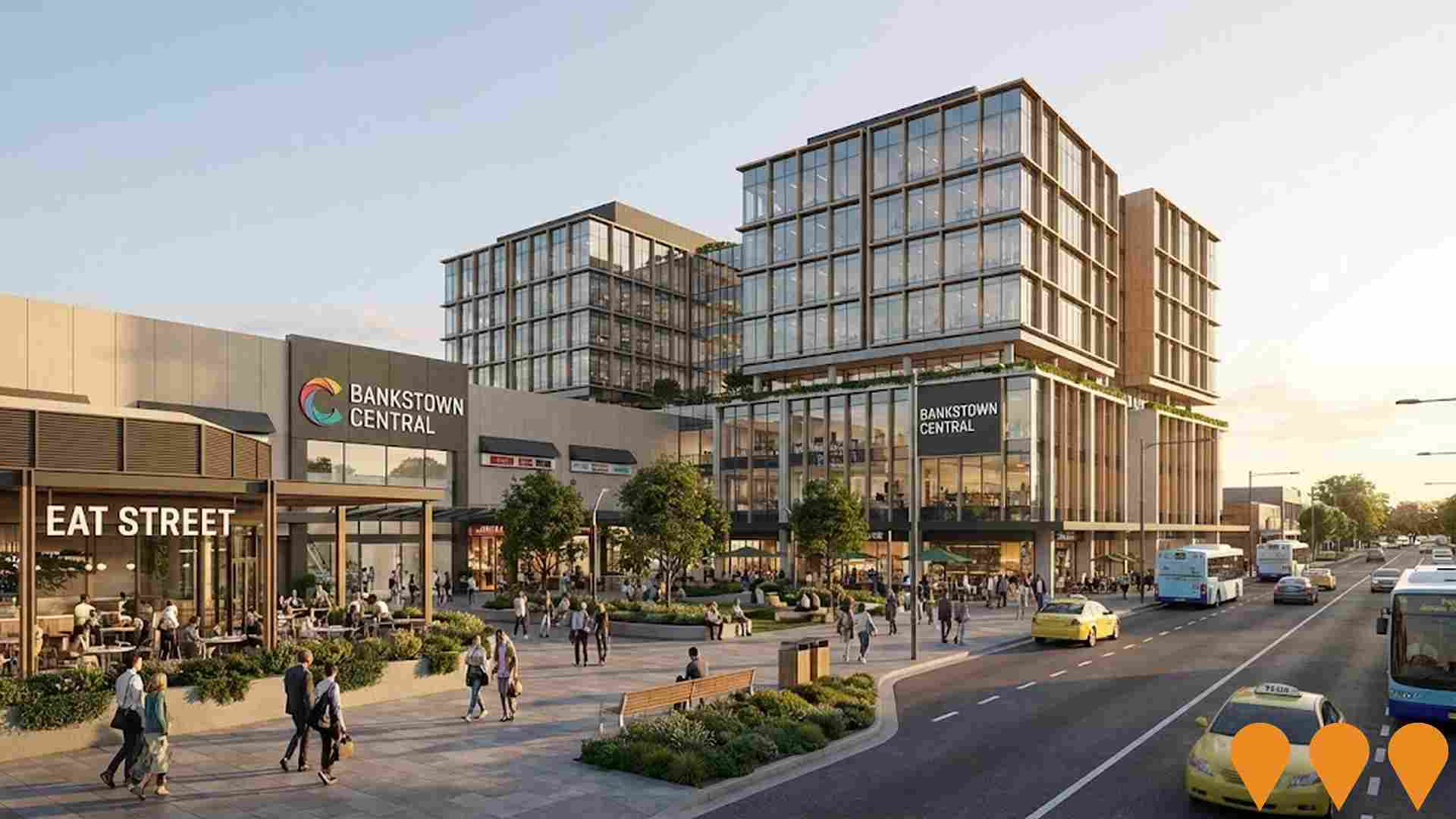
Salt Pan Creek Channel Repairs
Structural repairs and bank stabilization along Salt Pan Creek within the Cooks River catchment, affecting parts of Greenacre, Punchbowl, Belfield and nearby suburbs. Scope includes flood mitigation, stormwater channel rehabilitation, erosion control and environmental restoration works to improve waterway health and reduce flood risk.
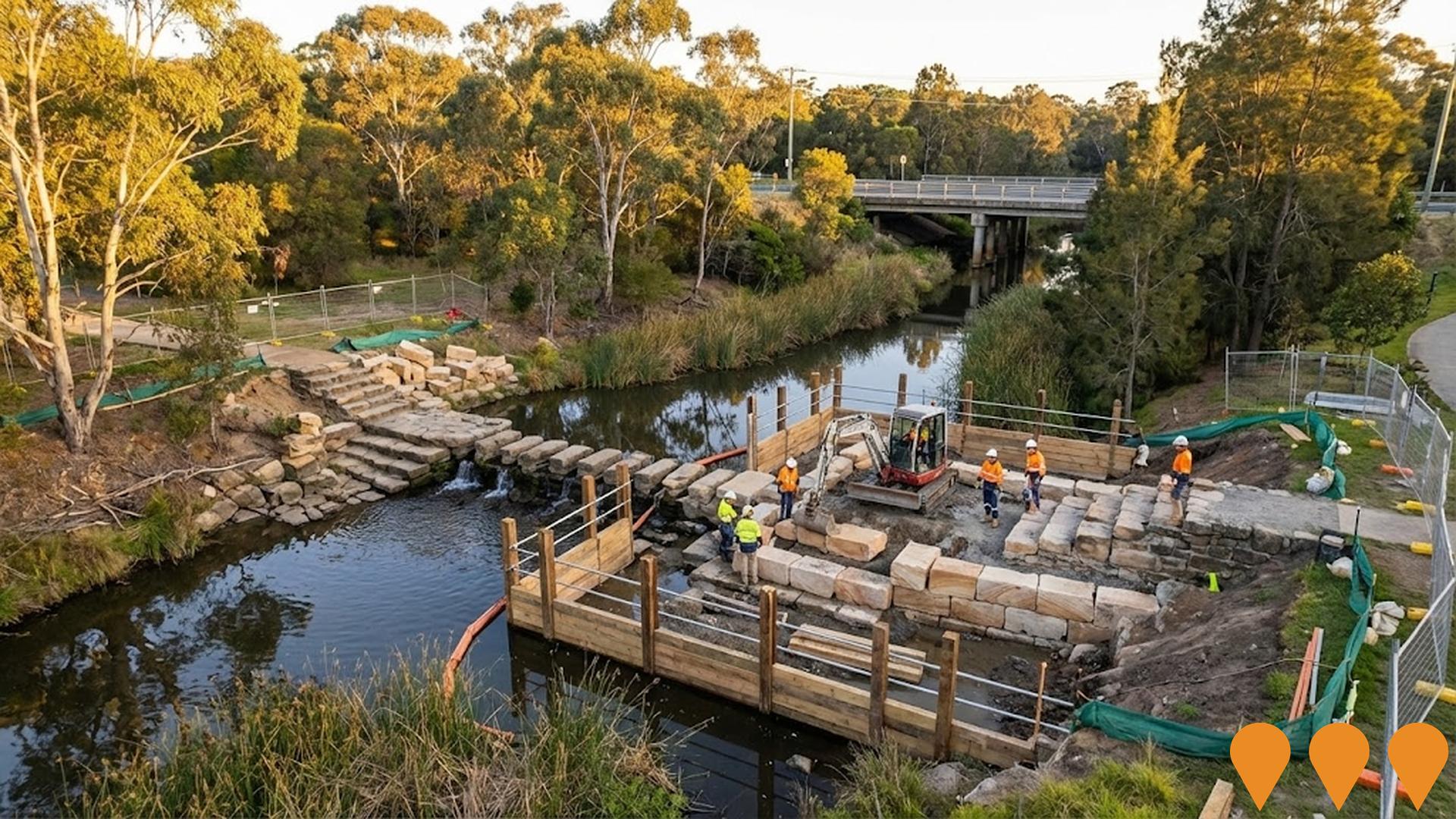
Yagoona Public Preschool
New public preschool facility to be built at Yagoona Public School site as part of NSW Government's $769 million plan to deliver 100 new public preschools. Will provide early childhood education services for local community with completion expected by 2027.

Appian Way and North Terrace Drainage Upgrades
Part of the broader 'Bankstown CBD stormwater upgrade'. The project will upgrade the stormwater network to accommodate a one-in-a-hundred-year flood event, a twenty-fold increase on the current capacity. The work involves increasing drainage capacity under the road surfaces of North Terrace, The Appian Way and The Mall using pipes and culverts. The project is being delivered in three stages, with Stage 3 commencing in May 2025.

Power Supply Upgrade - Yagoona Station
Electrical infrastructure upgrade at Yagoona Railway Station to support increased capacity and future metro conversion. Part of broader Sydney Metro infrastructure preparation works across the Bankstown line corridor.

Employment
The labour market performance in Yagoona - Birrong lags significantly behind most other regions nationally
Yagoona - Birrong has a skilled workforce with diverse sector representation. Its unemployment rate was 8.7% in June 2025, which is 0.3 percentage points higher than Greater Sydney's rate of 4.2%.
Employment growth over the past year was estimated at 2.1%. As of June 2025, there were 9,751 residents employed. Workforce participation in Yagoona - Birrong lags behind Greater Sydney at 44.3% compared to 60.0%. Leading employment industries among residents include health care & social assistance, retail trade, and transport, postal & warehousing.
The area has a notable concentration in transport, postal & warehousing, with employment levels at 1.8 times the regional average. However, professional & technical services employ only 6.8% of local workers, below Greater Sydney's 11.5%. AreaSearch analysis of SALM and ABS data shows that during the year to June 2025, employment levels increased by 2.1%, while labour force increased by 2.5%. This resulted in an unemployment rise of 0.4 percentage points. In comparison, Greater Sydney recorded employment growth of 2.6% and labour force growth of 2.9%, with unemployment rising by 0.3 percentage points. Jobs and Skills Australia's national employment forecasts from May 2025 suggest that national employment will expand by 6.6% over five years and 13.7% over ten years. Applying these projections to Yagoona - Birrong's employment mix suggests local growth of approximately 6.3% over five years and 13.2% over ten years, based on a simple weighting extrapolation for illustrative purposes.
Frequently Asked Questions - Employment
Income
Income figures position the area below 75% of locations analysed nationally by AreaSearch
Yagoona - Birrong had a median taxpayer income of $41,154 and an average of $52,450 in financial year 2022. This was lower than the national average, contrasting with Greater Sydney's median income of $56,994 and average income of $80,856. By September 2025, current estimates suggest a median income of approximately $46,344 and an average of $59,064 based on Wage Price Index growth of 12.61%. According to the 2021 Census, individual incomes were at the 5th percentile ($528 weekly), while household incomes performed better at the 33rd percentile. The income bracket of $1,500 - 2,999 dominated with 30.9% of residents (7,235 people), mirroring regional levels where 30.9% occupied this bracket. Housing affordability pressures were severe, with only 78.8% of income remaining, ranking at the 26th percentile.
Frequently Asked Questions - Income
Housing
Yagoona - Birrong displays a diverse mix of dwelling types, with a higher proportion of rental properties than the broader region
The dwelling structure in Yagoona-Birrong, as per the latest Census, consisted of 67.1% houses and 32.9% other dwellings (semi-detached, apartments, 'other' dwellings). This compares to Sydney metro's 61.5% houses and 38.4% other dwellings. Home ownership in Yagoona-Birrong was at 30.1%, with the remaining dwellings either mortgaged (31.6%) or rented (38.2%). The median monthly mortgage repayment in the area was $2,131, lower than Sydney metro's average of $2,240. The median weekly rent figure was recorded at $400, compared to Sydney metro's $425. Nationally, Yagoona-Birrong's mortgage repayments are higher at $2,131 versus the Australian average of $1,863, while rents exceed the national figure of $375 at $400.
Frequently Asked Questions - Housing
Household Composition
Yagoona - Birrong features high concentrations of family households, with a higher-than-average median household size
Family households account for 77.8% of all households, including 42.6% couples with children, 17.5% couples without children, and 16.0% single parent families. Non-family households constitute the remaining 22.2%, with lone person households at 19.8% and group households making up 2.4%. The median household size is 3.2 people, which is larger than the Greater Sydney average of 3.1.
Frequently Asked Questions - Households
Local Schools & Education
Educational outcomes in Yagoona - Birrong fall within the lower quartile nationally, indicating opportunities for improvement in qualification attainment
The area's university qualification rate is 23.5%, significantly lower than Greater Sydney's average of 38.0%. Bachelor degrees are the most common at 17.3%, followed by postgraduate qualifications (5.1%) and graduate diplomas (1.1%). Vocational credentials are prevalent, with 27.3% of residents aged 15+ holding them, including advanced diplomas (10.5%) and certificates (16.8%). Educational participation is high at 33.9%, comprising 11.3% in primary, 9.3% in secondary, and 6.5% in tertiary education.
Six schools educate approximately 2,310 students in Yagoona - Birrong, with typical Australian school conditions (ICSEA: 972) and balanced educational opportunities. Four primary and two secondary schools serve distinct age groups, with school places per 100 residents at 9.9, below the regional average of 16.8, indicating some students may attend adjacent areas' schools. Note: for schools showing 'n/a' in enrolments, refer to their parent campus.
Frequently Asked Questions - Education
Schools Detail
Nearby Services & Amenities
Transport
Transport servicing is high compared to other areas nationally based on assessment of service frequency, route connectivity and accessibility
Transport analysis shows 125 active stops operating in Yagoona-Birrong area. These include both train and bus services. There are 35 individual routes serving these stops, collectively handling 6466 weekly passenger trips.
Residential accessibility to transport is rated excellent, with residents typically located 139 meters from the nearest stop. Service frequency averages 923 trips per day across all routes, equating to approximately 51 weekly trips per stop.
Frequently Asked Questions - Transport
Transport Stops Detail
Health
Yagoona - Birrong's residents are extremely healthy with younger cohorts in particular seeing very low prevalence of common health conditions
Analysis of health metrics shows strong performance throughout Yagoona-Birrong with younger cohorts seeing very low prevalence of common health conditions. The rate of private health cover is extremely low at approximately 46% of the total population (~10,817 people), compared to 48.6% across Greater Sydney and a national average of 55.3%. The most common medical conditions in the area are arthritis and asthma, impacting 6.0 and 6.0% of residents respectively, while 76.1% declared themselves completely clear of medical ailments compared to 75.8% across Greater Sydney.
As of 2021, the area has 16.0% of residents aged 65 and over (3,751 people). Health outcomes among seniors are above average but require more attention than the broader population.
Frequently Asked Questions - Health
Cultural Diversity
Yagoona - Birrong is among the most culturally diverse areas in the country based on AreaSearch assessment of a range of language and cultural background related metrics
Yagoona-Birrong is among the most culturally diverse areas in Australia, with 47.4% of its population born overseas and 69.8% speaking a language other than English at home. The dominant religion in Yagoona-Birrong, as per data from June 2016, is Christianity, comprising 41.5% of the population. Islam is notably overrepresented, making up 33.0%, which is higher than the Greater Sydney average of 27.9%.
In terms of ancestry, the top three groups in Yagoona-Birrong are 'Other', at 20.4%, Lebanese at 18.4%, and Vietnamese at 14.7%, which is substantially higher than the regional average of 8.5%. Additionally, there are notable differences in the representation of certain ethnic groups: Macedonian is overrepresented at 3.1% compared to the regional average of 1.7%, Samoan at 0.7% (regional average 0.5%), and Chinese at 7.7% (regional average 7.6%).
Frequently Asked Questions - Diversity
Age
Yagoona - Birrong's population is younger than the national pattern
Yagoona-Birrong has a median age of 35 years, which is slightly younger than Greater Sydney's 37 years and somewhat younger than Australia's national average of 38 years. The 5-14 age group comprises 14.0% of the population, higher than in Greater Sydney, while the 35-44 cohort makes up 12.8%. Between 2021 and present, the 75-84 age group has increased from 4.1% to 5.0% of the population. Conversely, the 55-64 age group has decreased from 11.7% to 10.7%. By 2041, Yagoona-Birrong's population is projected to see significant demographic changes. The 75-84 age cohort is expected to rise substantially by 883 people (75%), from 1,177 to 2,061. Notably, the combined 65+ age groups will account for 69% of total population growth, indicating an aging demographic trend. In contrast, both the 5-14 and 0-4 age groups are projected to decrease in numbers.


